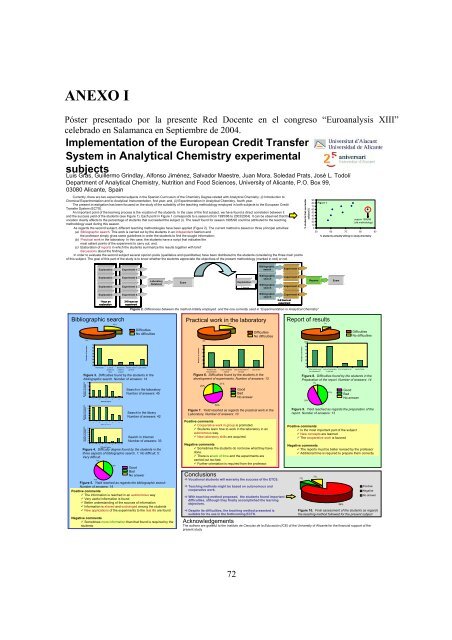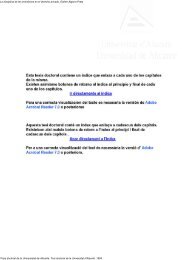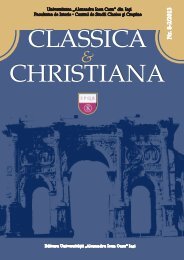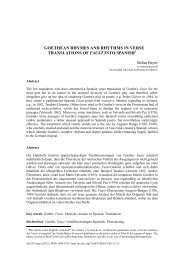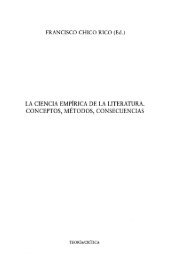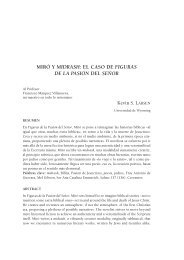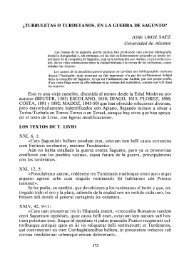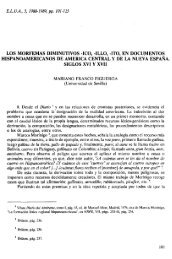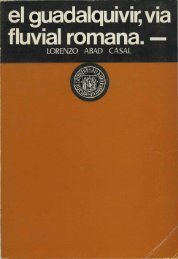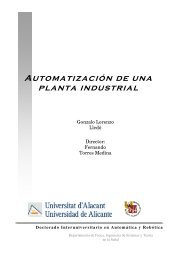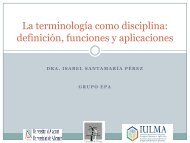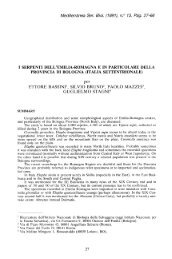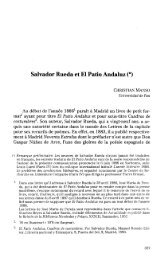- Page 1 and 2:
Vicerrectorado de Convergencia Euro
- Page 3 and 4:
DENOMINACIÓN DE LA ASIGNATURA: CIT
- Page 5 and 6:
Estudios sobre Biología e impacto
- Page 7 and 8:
7. Otras disciplinas con las que se
- Page 9 and 10:
A) Importancia de los objetivos afe
- Page 11 and 12:
objetividad es una tarea difícil p
- Page 13 and 14:
V. BLOQUES Y TEMAS DE CONTENIDO La
- Page 15 and 16:
características de sus componentes
- Page 17 and 18:
Tema 23: Almacenamiento intracelula
- Page 19 and 20:
Platelmintos, Rincocelos, Anelidos,
- Page 21 and 22:
Tema 54: Floema o liber. Floema pri
- Page 23 and 24:
Práctica 14. Estudio microscópico
- Page 25 and 26:
• Todos debemos ser conscientes q
- Page 27 and 28:
Confirmación de presentación a lo
- Page 29 and 30:
gráficos, etc.) es básica para en
- Page 31 and 32:
• Un 10 en las actividades comple
- Page 33 and 34:
IX. ESCALA DE GRADO Las notas se as
- Page 35 and 36:
8) GARTNER, L.P. Y HIATT, L.P. (199
- Page 37 and 38:
• La idea de la red es trabajar e
- Page 39 and 40:
En ambos casos, el trabajo a realiz
- Page 41:
El Departamento de Biotecnología u
- Page 44 and 45:
INFORME SOBRE EL ESTADO DE LA INVES
- Page 46 and 47:
Vicerrectorado de Convergencia Euro
- Page 48 and 49:
1. Guía Docente de la Asignatura:
- Page 50 and 51:
1.1.2 Ubicación y relaciones en el
- Page 52 and 53:
4. Alcanzar capacidad para argument
- Page 54 and 55:
3. Ajuste de reacciones químicas i
- Page 56 and 57:
4. Puesta en común de los problema
- Page 58 and 59:
1.6.- Plan de trabajo de los alumno
- Page 60 and 61:
1.8.- Evaluación de los aprendizaj
- Page 62 and 63:
2.- Adecuación del programa al fut
- Page 64 and 65:
Tabla II (continuación) Curso Deno
- Page 66 and 67: En la Figura 4 se ha tenido en cuen
- Page 68 and 69: Los resultados aparecen reflejados
- Page 70 and 71: Grupo Número Grp-1 32 Grp-2 22 Grp
- Page 72 and 73: 5.- Evolución del método docente
- Page 74 and 75: 6.- Encuesta cualitativa: EXPERIMEN
- Page 76 and 77: El alumno debe indicar las dificult
- Page 78 and 79: Se persigue con esta cuestión cono
- Page 80 and 81: Resultados de la encuesta cualitati
- Page 82 and 83: En lo referente al esfuerzo y tiemp
- Page 84 and 85: presente asignatura es la asimilaci
- Page 86 and 87: “El tiempo y el esfuerzo ha sido
- Page 88 and 89: curiosidad, lo cual indica que, rea
- Page 90 and 91: 29% 50% 21% Menor que el esperado E
- Page 92 and 93: Sin dificultades Con dificultades (
- Page 94 and 95: Un buen número de alumnos cree que
- Page 96 and 97: ibliográfica, se deja trabajar con
- Page 98 and 99: 3. ¿Cómo estimarías el rendimien
- Page 100 and 101: 7.- Encuesta cuantitativa: EXPERIME
- Page 102 and 103: Frecuencia 20 15 10 5 (a) (b) Frecu
- Page 104 and 105: Frecuencia 20 15 10 5 0 (a) 1 2 3 4
- Page 106 and 107: Frecuencia 14 12 10 8 6 4 2 0 (a) 1
- Page 108 and 109: ACTIVIDADES DE ENSEÑANZA APRENDIZA
- Page 110 and 111: Tabla VIII. Ejemplo de un informe d
- Page 112 and 113: ii. Se incluyen dos actividades adi
- Page 114 and 115: 8. Evaluación del cumplimiento de
- Page 118 and 119: Vicerrectorado de Convergencia Euro
- Page 120 and 121: PRESENTACIÓN El nuevo milenio ha t
- Page 122 and 123: Para acabar proponemos una primera
- Page 124 and 125: 1. MARCO TEÓRICO 1.1. MARCO CONCEP
- Page 126 and 127: crítica, de procurar la aplicació
- Page 128 and 129: enseñanza ha de estar enlazada, en
- Page 130 and 131: adaptaciones curriculares más impo
- Page 132 and 133: un primer momento, para clarificar
- Page 134 and 135: Tomando como referente toda esa inf
- Page 136 and 137: disponemos los docentes para atende
- Page 138 and 139: 2.2.2. CONTEXTUALIZACIÓN La asigna
- Page 140 and 141: que el docente adquiere el rol de o
- Page 142 and 143: Es en estas bases en las que asenta
- Page 144 and 145: infancia y la adolescencia, así co
- Page 146 and 147: metodológicas y tecnológicas, que
- Page 148 and 149: A partir de estos objetivos señala
- Page 150 and 151: Se le exige al alumnado un mayor ni
- Page 152 and 153: 2.2.5. BIBLIOGRAFÍA RECOMENDADA BE
- Page 154 and 155: Estas clases presenciales también
- Page 156 and 157: Relacionadas con las actividades re
- Page 158 and 159: En las tutorías individuales la al
- Page 160 and 161: proponen con el programa Hotpotatoe
- Page 162 and 163: Presentación de varios casos prác
- Page 164 and 165: aumentando y quizás requiera de un
- Page 166 and 167:
es guiar al alumno/a en su camino h
- Page 168 and 169:
En cuanto al tercer instrumento de
- Page 170 and 171:
imposible delimitar una competencia
- Page 172 and 173:
aprendizaje de todos ellos; sí es
- Page 174 and 175:
BOE 14-09-2000 Plan de estudios Mae
- Page 176 and 177:
ANEXO 1 - TABLA O - RESUMEN PROCEDI
- Page 178 and 179:
. Desarrollar destrezas para manipu
- Page 180 and 181:
OBJETIVO 2. Desarrollar una actitud
- Page 182 and 183:
OBJETIVO 4. Desarrollar un grado de
- Page 184 and 185:
COMPETENCIAS INTERPERSONALES COMPET
- Page 186 and 187:
ANEXO 2 - TABLA I - CORRELACIÓN PE
- Page 188 and 189:
tabla 1. Correlación entre el perf
- Page 190 and 191:
Vicerrectorado de Convergencia Euro
- Page 192 and 193:
1. PERFIL PROFESIONAL DE MAESTRO: E
- Page 194 and 195:
3. PRELIMINAR El afrontar el estudi
- Page 196 and 197:
La respuesta es no sencilla, y más
- Page 198 and 199:
emoles. • Detectar y anotar las a
- Page 200 and 201:
12.2. El metrónomo 12.3. Valoraci
- Page 202 and 203:
3. Sistémicos 3.1. Integrar el con
- Page 204 and 205:
MÓDULO3: Conceptos fundamentales d
- Page 206 and 207:
• Trabajos de Campo (1 créditos
- Page 208 and 209:
OBJETIVOS GENERALES BLOQUES DE CONT
- Page 210 and 211:
Vicerrectorado de Convergencia Euro
- Page 212 and 213:
III PARTE: ESTUDIOS DE VALORACIÓN
- Page 214 and 215:
o El último tercio se obtendrá po
- Page 216 and 217:
Siendo estas cifras muy llamativas,
- Page 218 and 219:
Total 80 100,0 Diez alumnos obtiene
- Page 220 and 221:
2,00 15 33,3 2,30 2 4,4 3,00 9 20,0
- Page 222 and 223:
Asistencia a clase: 45 horas (inclu
- Page 224 and 225:
II PARTE: GUÍA DIDÁCTICA DE PSICO
- Page 226 and 227:
Desarrollará actividades encaminad
- Page 228 and 229:
2. Planificar, implementar, revisar
- Page 230 and 231:
estén insertos. Asimismo, los trab
- Page 232 and 233:
LA ASIGNATURA DE PSICOLOGÍA SOCIAL
- Page 234 and 235:
Tema 2: El Proceso de Socializació
- Page 236 and 237:
* Explicar las distintas orientacio
- Page 238 and 239:
Bibliografía: ARGYLE, M. (1990): R
- Page 240 and 241:
* A partir de la síntesis de Geen,
- Page 242 and 243:
5.1. Selección de Competencias Gen
- Page 244 and 245:
- Diseñar, implementar y evaluar p
- Page 246 and 247:
Ejemplo 1. El estudio pretende comp
- Page 248 and 249:
- aprender a exteriorizar sus senti
- Page 250 and 251:
1) Asociados al perceptor (entrevis
- Page 252 and 253:
4. Diseñar (y aplicar) una escala
- Page 254 and 255:
¿Qué sucede querida? - Amir se co
- Page 256 and 257:
Es una persona más o menos de tu e
- Page 258 and 259:
III PARTE: ESTUDIOS DE VALORACIÓN
- Page 260 and 261:
Tabla *. Posición señalada en el
- Page 262 and 263:
Tabla *. Tiempo dedicado a activida
- Page 264 and 265:
test y realización de prácticas.
- Page 266 and 267:
Sólo estudia 10 21,3 Estudia y hac
- Page 268 and 269:
El 61,7% de los alumnos consideran
- Page 270 and 271:
Tabla 14. En relación a las práct
- Page 272 and 273:
nc 2 4,3 Total 47 100,0 - Leer los
- Page 274 and 275:
asistencia regular a clase y la ela
- Page 276 and 277:
Frecuencia 50 40 30 20 10 0 Edad Fr
- Page 278 and 279:
Calificación de acceso a la preins
- Page 280 and 281:
Tabla 12. Tiempo (en horas) dedicad
- Page 282 and 283:
Tabla 20. Vista global de los resul
- Page 284 and 285:
Tabla 26. El sistema de evaluación
- Page 286 and 287:
ANEXO I GLOSARIO DE PSICOLOGÍA SOC
- Page 288 and 289:
Exogrupo Experimento de Cimbrado Ex
- Page 290 and 291:
Teoría de la Autopercepción Teor
- Page 292 and 293:
Gibb, J.R. Glass y Singer Goffman.
- Page 294 and 295:
Vicerrectorado de Convergencia Euro
- Page 296 and 297:
La educación especial en los estud
- Page 298 and 299:
La educación especial en los estud
- Page 300 and 301:
La educación especial en los estud
- Page 302 and 303:
La educación especial en los estud
- Page 304 and 305:
La educación especial en los estud
- Page 306 and 307:
La educación especial en los estud
- Page 308 and 309:
La educación especial en los estud
- Page 310 and 311:
La educación especial en los estud
- Page 312 and 313:
La educación especial en los estud
- Page 314 and 315:
La educación especial en los estud
- Page 316 and 317:
La educación especial en los estud
- Page 318 and 319:
La educación especial en los estud
- Page 320 and 321:
Vicerrectorado de Convergencia Euro
- Page 322 and 323:
proyecto de elaboración de materia
- Page 324 and 325:
IV. DESARROLLO DEL TRABAJO: PROBLEM
- Page 326 and 327:
los planes de estudio tampoco permi
- Page 328 and 329:
nivel de conocimientos. Sin embargo
- Page 330 and 331:
GUÍA DOCENTE DE LA ASIGNATURA LAT
- Page 332 and 333:
Módulo 2: Módulo 3: f.-Conocer la
- Page 334 and 335:
Nociones básicas de la historia de
- Page 336 and 337:
1.3.3.3.5. Consecutivas 1.3.3.3.6.
- Page 338 and 339:
Como se puede observar, en cada uno
- Page 340 and 341:
El alumnado debe aprobar cada uno d
- Page 342 and 343:
f.-Conocimiento, desde una perspect
- Page 344 and 345:
MÓDULO 3: POESÍA LATINA TARDORREP
- Page 346 and 347:
MÓDULO 5: PROSA TARDORREPUBLICANA:
- Page 348 and 349:
-La obra de Gayo Valerio Catulo: de
- Page 350 and 351:
Módulo I Módulo II Módulo III M
- Page 352 and 353:
8. SISTEMA DE EVALUACIÓN DEL APREN
- Page 354 and 355:
VI. VALORACIÓN DE LOS RESULTADOS Y
- Page 356 and 357:
IX. ANEXOS Incluimos como anexos la
- Page 358 and 359:
2ª REUNIÓN DE REDFILAT: ECTS EN F
- Page 360 and 361:
4ª REUNIÓN DE REDFILAT: ECTS EN F
- Page 362 and 363:
6ª REUNIÓN DE REDFILAT: ECTS EN F
- Page 364 and 365:
8ª REUNIÓN DE REDFILAT: ECTS EN F
- Page 366 and 367:
10ª REUNIÓN DE REDFILAT: ECTS EN
- Page 368 and 369:
1. Abstract 2. Marco teórico ÍNDI
- Page 370 and 371:
grado 3 supone la plasmación de la
- Page 372 and 373:
notable singularidad, 5 como es el
- Page 374 and 375:
3. METODOLOGÍA SEGUIDA Como se pue
- Page 376 and 377:
o TUNING Project, (2002): History:
- Page 378 and 379:
aportaciones individuales con que y
- Page 380 and 381:
COMPETENCIAS INSTRUMENTALES (cont.)
- Page 382 and 383:
COMPETENCIAS ACTITUDINALES INDIVIDU
- Page 384 and 385:
5. DISCUSIÓN DE LOS RESULTADOS El
- Page 386 and 387:
Consideramos que, en parte, los log
- Page 388 and 389:
ANEXO I INFORMES DE LAS SESIONES DE
- Page 390 and 391:
Red ECTS en filología 18.2.04 Semi
- Page 392 and 393:
Reunión red ECTS en Filología 2.3
- Page 394 and 395:
Reunión red ECTS en Filología 30.
- Page 396 and 397:
Red ECTS en filología 7.4.04 Semin
- Page 398 and 399:
Red ECTS en filología 4.5.04 Semin
- Page 400 and 401:
ANEXO II CATÁLOGOS INDIVIDUALES DE
- Page 402 and 403:
Competencias específicas - Capacid
- Page 404 and 405:
• Capacitat d’organitzar col·l
- Page 406 and 407:
connexiَ (especialment els connect
- Page 408 and 409:
oralment i per escrit, dels conting
- Page 410 and 411:
Utilizar el internet para hacer bú
- Page 412 and 413:
- Utilización de los recursos bibl
- Page 414 and 415:
-Profundizar en las relaciones temp
- Page 416 and 417:
Destrezas tecnológicas -Capacidad
- Page 418 and 419:
vii. Opinión: expresar el acuerdo
- Page 420 and 421:
LITERATURA A COMPETENCIAS BÁSICAS:
- Page 422 and 423:
BORRADOR 3.5.04 Competencias Instru
- Page 424 and 425:
BORRADOR 6.5.04 Competencias Instru
- Page 426 and 427:
Compromiso con el trabajo • Cumpl
- Page 428 and 429:
Procedimentales o metodológibas
- Page 430:
COMPETENCIAS SISTÉMICAS Cap. 6.1.3
- Page 433 and 434:
Procedimentales o metodológicas
- Page 435:
COMPETENCIAS SISTÉMICAS Cap. 6.1.3
- Page 438 and 439:
Procedimentales o metodológicas
- Page 440 and 441:
COMPETENCIAS SISTÉMICAS Individual
- Page 442 and 443:
BORRADOR 24.9.04 COMPETENCIAS INSTR
- Page 444 and 445:
Tecnológicas • Ser capaz de util
- Page 446 and 447:
úsqueda de manera escrita y hablad
- Page 448 and 449:
Vicerrectorado de Convergencia Euro
- Page 450 and 451:
Estudio de la adaptación de asigna
- Page 452 and 453:
Estudio de la adaptación de asigna
- Page 454 and 455:
Estudio de la adaptación de asigna
- Page 456 and 457:
Estudio de la adaptación de asigna
- Page 458 and 459:
Estudio de la adaptación de asigna
- Page 460 and 461:
Estudio de la adaptación de asigna
- Page 462 and 463:
Estudio de la adaptación de asigna
- Page 464 and 465:
Estudio de la adaptación de asigna
- Page 466 and 467:
Estudio de la adaptación de asigna
- Page 468 and 469:
Estudio de la adaptación de asigna
- Page 470 and 471:
Estudio de la adaptación de asigna
- Page 472 and 473:
Estudio de la adaptación de asigna
- Page 474 and 475:
Estudio de la adaptación de asigna
- Page 476 and 477:
Estudio de la adaptación de asigna
- Page 479:
Presentación Esta memoria recoge l
- Page 482 and 483:
IV Índice general 2.1. Objetivos .
- Page 485 and 486:
1. Marco teórico Las universidades
- Page 487:
1.1 El crédito europeo 5 exclusiva
- Page 490 and 491:
8 2 Implementación de la investiga
- Page 492 and 493:
10 2 Implementación de la investig
- Page 494 and 495:
12 3 Discusión de los resultados y
- Page 496 and 497:
14 3 Discusión de los resultados y
- Page 499 and 500:
1. Contextualización En este prime
- Page 501 and 502:
1.2 Enseñanza en Metodología y Te
- Page 503 and 504:
1.2.3 Relación con otras asignatur
- Page 505 and 506:
LENGUAJES, GRAMÁTICAS y AUTÓMATAS
- Page 507 and 508:
PROGRAMACIÓN ORIENTADA A OBJETOS A
- Page 509 and 510:
1.2 Enseñanza en Metodología y Te
- Page 511 and 512:
1.2 Enseñanza en Metodología y Te
- Page 513 and 514:
PF3. Estructuras de datos fundament
- Page 515 and 516:
2. Objetivos, competencias y prerre
- Page 517 and 518:
2.2 Competencias 2.2 Competencias 3
- Page 519 and 520:
2.2 Competencias 37 En lo referente
- Page 521:
2.2.3 Competencias sistémicas 2.3
- Page 524 and 525:
42 3 Contenidos 3.1 Contenidos de t
- Page 526 and 527:
44 3 Contenidos 2.2 Inducción estr
- Page 528 and 529:
46 3 Contenidos Dispone de capítul
- Page 530 and 531:
48 3 Contenidos KNUTH, D.E. (1973).
- Page 532 and 533:
50 3 Contenidos 3.3 Contenidos de p
- Page 535 and 536:
4. Consideraciones metodológicas E
- Page 537 and 538:
4.2 Estrategias de aprendizaje 55 E
- Page 539 and 540:
4.2 Estrategias de aprendizaje 57 i
- Page 541 and 542:
4.3 El proceso de evaluación 4.3 E
- Page 543:
4.3 El proceso de evaluación 61
- Page 547 and 548:
Bibliografía ACM 1968 (1968). ✭
- Page 549 and 550:
Vicerrectorado de Convergencia Euro
- Page 551 and 552:
descubrir el origen de esta diferen
- Page 553 and 554:
Finalmente, señalar que la preocup
- Page 555 and 556:
1.3. COORDENADAS CIENTÍFICAS: SUPU
- Page 557 and 558:
problemas de salud como si sólo ex
- Page 559 and 560:
1.4 JUSTIFICACIÓN DEL SISTEMA DE N
- Page 561 and 562:
indispensables para que la vida ps
- Page 563 and 564:
Esta contextualización de objeto i
- Page 565 and 566:
1.8 LA POSIBILIDAD DE OPCIÓN DE VI
- Page 567 and 568:
de los mismos. Para ello la program
- Page 569 and 570:
enfermería consiste en introducir
- Page 571 and 572:
ealista posible, del cuándo, es de
- Page 573 and 574:
6 CRÉDITOS (180H) .-3 créditos te
- Page 575 and 576:
queden satisfechas dentro del lími
- Page 577 and 578:
domésticos. Estructuras sociales y
- Page 579 and 580:
enfermería civil y laica. • La L
- Page 581 and 582:
3.3.1.2.3 BIBLIOGRAFIA AMEZCUA, M.
- Page 583 and 584:
3.3.1.3 UNIDAD TEMÁTICA II: FUNDAM
- Page 585 and 586:
Tema 18: El método científico.
- Page 587 and 588:
GEERTZ, C. (1994) Conocimiento loca
- Page 589 and 590:
del análisis de textos. Enfermerí
- Page 591 and 592:
• Identificar y analizar crítica
- Page 593 and 594:
BLUMER H. (1982) El interaccionsmo
- Page 595 and 596:
3.3.2 MÓDULO TEÓRICO-PRÁCTICO El
- Page 597 and 598:
• Identificar, analizar y sinteti
- Page 599 and 600:
SABATO, E. (1987) Apologías y rech
- Page 601 and 602:
cognitivos (conocimientos, informac
- Page 603 and 604:
Seminarios-taller (módulo teórico
- Page 605 and 606:
La evaluación del alumno se estruc
- Page 607 and 608:
Enfermería. México: Manual Modern
- Page 609 and 610:
POSTMAN, N. (1991) Divertirse hasta
- Page 611 and 612:
Vicerrectorado de Convergencia Euro
- Page 613 and 614:
DENOMINACIÓN DE LA ASIGNATURA: ENF
- Page 615 and 616:
TEMA 1.10.- CUIDADOS DE ENFERMERÍA
- Page 617 and 618:
Seminario 4.- URGENCIAS INFANTILES.
- Page 619 and 620:
Conocimiento de las enfermedades m
- Page 621 and 622:
Nivel psicomotor Identificar y prep
- Page 623 and 624:
17.- Aplicación y control de fotot
- Page 625 and 626:
DENOMINACIÓN DE LA ASIGNATURA: ENF
- Page 627 and 628:
III. COMPETENCIAS ACADÉMICAS Y PRO
- Page 629 and 630:
5.1. CONTENIDOS TEÓRICOS BLOQUE TE
- Page 631 and 632:
Unidad temática II: Traumatismos:
- Page 633 and 634:
BLOQUE TEMÁTICO VIII: TÉCNICAS DE
- Page 635 and 636:
VI. METODOLOGÍA Y ESTRATEGIAS DE A
- Page 637 and 638:
asignatura (Campus Virtual). • Ap
- Page 639 and 640:
8.3. CRITERIOS PARA LA EVALUACIÓN
- Page 641 and 642:
KONRADI, D. y STOCKERT, P. (1990).
- Page 643 and 644:
MARTÍNEZ, J.C. (1998). El tacto, u
- Page 645 and 646:
Guía Gu a Docente Asignatura: Fund
- Page 647 and 648:
Contextualización Contextualizaci
- Page 649 and 650:
Organización Organizaci n Modular
- Page 651 and 652:
Contextualización Contextualizaci
- Page 653 and 654:
Fundamentos Teóricos( Te ricos(lll
- Page 655 and 656:
Fundamentos Teóricos Te ricos (V)
- Page 657 and 658:
Fundamentos Metodológicos Metodol
- Page 659 and 660:
Fundamentos Metodológicos Metodol
- Page 661 and 662:
CONSIDERACIONES EN RELACIÓN RELACI
- Page 663 and 664:
Bibliografía Bibliograf a (1) EL
- Page 665 and 666:
Bibliografía Bibliograf a (3) HAC
- Page 667 and 668:
DIAGN Bibliografía Bibliograf a (5
- Page 669 and 670:
Contextualización • La materia t
- Page 671 and 672:
Módulo de prácticas clínicas. M
- Page 673 and 674:
Fundamentos de Enfermería. Módulo
- Page 675 and 676:
Fundamentos de Enfermería. Módulo
- Page 677 and 678:
Fundamentos de Enfermería. Módulo
- Page 679 and 680:
Fundamentos de Enfermería. Módulo
- Page 681 and 682:
Normas de evaluación. Normas de ev
- Page 683 and 684:
ENFERMERÍA EN SALUD MENTAL Y PSIQU
- Page 685 and 686:
E-mail: Luis.Cibanal@ua.es Tutoría
- Page 687 and 688:
Aplicación del Modelo de Callista
- Page 689 and 690:
• Comunicación y Relación de Ay
- Page 691 and 692:
SISTEMA DE EVALUACIÓN. La evaluaci
- Page 693 and 694:
• Garrido Medina L, Gil Calvo E.
- Page 695 and 696:
• El tercer año, en el que nos e
- Page 697 and 698:
En la reunión del miércoles 21, d
- Page 699 and 700:
OBJETIVOS DOCENTES A) NIVEL PREGRAD
- Page 706 and 707:
INFORME SOBRE EL ESTADO DE LA INVES
- Page 708 and 709:
valoración de los participantes de
- Page 710 and 711:
Resumen Objetivos: la Declaración
- Page 712 and 713:
El propósito de este nuevo sistema
- Page 714 and 715:
campo/ laboratorio o biblioteca) Tu
- Page 716 and 717:
Como profesional liberal, se puede
- Page 718 and 719:
C) COMPETENCIAS ESPECÍFICAS MÓDUL
- Page 720 and 721:
Concepto de promoción de la salud
- Page 722 and 723:
7. Integrar el concepto de calidad
- Page 724 and 725:
3. Interpretar las medidas de frecu
- Page 726 and 727:
Introducción y presentación de lo
- Page 728 and 729:
G) BIBLIOGRAFÍA En la preparación
- Page 730 and 731:
BIBLIOGRAFÍA 1. Programa de Conver
- Page 732 and 733:
Demostrar actitudes favorables a la
- Page 734 and 735:
Vicerrectorado de Convergencia Euro
- Page 736 and 737:
Finalmente, en la Cumbre de Jefes d
- Page 738 and 739:
aplicable, sus formas de medirlo, v
- Page 740 and 741:
Elementos para desenvolverse en el
- Page 742 and 743:
los objetivos generales de la Escue
- Page 744 and 745:
• Identificar los determinantes d
- Page 746 and 747:
Competencias Interpersonales Compet
- Page 748 and 749:
Tema 2.- Descripción numérica de
- Page 750 and 751:
Prácticas de aula informática A t
- Page 752 and 753:
Tema 3.- Niveles de Intervención e
- Page 754 and 755:
Bloque IV. Sistemas de registro: hi
- Page 756 and 757:
Recursos Materiales: - Todos los di
- Page 758 and 759:
los tres parámetros mencionados. L
- Page 760 and 761:
Vicerrectorado de Convergencia Euro
- Page 762 and 763:
1.- INTRODUCCIÓN La mejora de la c
- Page 764 and 765:
educativos superiores europeos medi
- Page 766 and 767:
- Real Decreto 285/2004, de 20 de f
- Page 768 and 769:
4. Contenidos. 5. Metodología doce
- Page 770 and 771:
Así, se establece un enfoque sist
- Page 772 and 773:
Además, en esta fase también se d
- Page 774 and 775:
- Curso sobre diseño de docencia n
- Page 776 and 777:
últimas en el segundo), aunque en
- Page 778 and 779:
y específicos de los departamentos
- Page 780 and 781:
de empresas. Concretamente, dentro
- Page 782 and 783:
TEMA 4.- ANÁLISIS INTERNO 4.1. Los
- Page 784 and 785:
analizar detalladamente el caso ant
- Page 786 and 787:
técnicas apropiadas conduce al log
- Page 788 and 789:
esfuerzo puede ayudar a una mejor p
- Page 790 and 791:
Vicerrectorado de Convergencia Euro
- Page 792 and 793:
PROYECTO REDES DE INVESTIGACIÓN EN
- Page 794 and 795:
implantación del Sistema Europeo d
- Page 796 and 797:
informáticos, facilitando enormeme
- Page 798 and 799:
obstante, debemos reconocer que, pu
- Page 800 and 801:
Las etapas seguidas en el proceso d
- Page 802 and 803:
alumno de RRLL y c) las fotocopias
- Page 804 and 805:
Uno de los aspectos que debemos ten
- Page 806 and 807:
Tabla 1. Dificultades encontradas 1
- Page 808 and 809:
disponía de un contacto en la empr
- Page 810 and 811:
En general, el resultado del trabaj
- Page 812 and 813:
Tabla 5. Valoración 5. Valoración
- Page 814 and 815:
profesional de nuestros alumnos al
- Page 816 and 817:
será el sistema de evaluación y l
- Page 818 and 819:
directivos a que quieran colaborar,
- Page 820 and 821:
acciones de mejora: intentar dismin
- Page 822 and 823:
Gore, C., Steven, V. y Bailey, M. (
- Page 824 and 825:
2. CONTEXTUALIZACIÓN El origen de
- Page 826 and 827:
• Saber cómo ser, que incluiría
- Page 828 and 829:
El ejercicio de la profesión libre
- Page 830 and 831:
FUNCIONES PROFESIONAL LIBERAL EMPLE
- Page 832 and 833:
• Conocer las características de
- Page 834 and 835:
OBJETIVO BLOQUE DE CONTENIDO COMPET
- Page 836 and 837:
cómo el grado de formalización de
- Page 838 and 839:
Parte III: Formulación Estratégic
- Page 840 and 841:
Tema 6.- ANÁLISIS INTERNO DESDE LA
- Page 842 and 843:
6. METODOLOGÍA DOCENTE 6.1. Metodo
- Page 844 and 845:
• Estudio y comentario de casos (
- Page 846 and 847:
• La resolución de los casos pro
- Page 848 and 849:
ANEXO II DIARIO DE APRENDIZAJE DE L
- Page 850 and 851:
2.6. Visita física a la empresa 2.
- Page 852 and 853:
1. IDENTIFICACIÓN DE LA ASIGNATURA
- Page 854 and 855:
4. COMPETENCIAS a. Competencias Ins
- Page 856 and 857:
• Grupo mediano. Un grupo mediano
- Page 858 and 859:
Semana 4 L: 18 oct. V: 22 oct. Sema
- Page 860 and 861:
Semana 14 L: 10 dic. V: 14 dic. TRA
- Page 862 and 863:
Si se supera la evaluación continu
- Page 864 and 865:
I. VALORACIÓN DE LA COORDINADORA D
- Page 866 and 867:
elaboración de las mismas. Se da f
- Page 868 and 869:
4. SUGERENCIAS Creemos que las rede
- Page 870 and 871:
Anexo 1: Documentación básica rev
- Page 872 and 873:
PROYECTO DE ENSEÑANZA-APRENDIZAJE
- Page 874 and 875:
El Plan de Estudios de la Escuela U
- Page 876 and 877:
2. Planificar, poner en práctica,
- Page 878 and 879:
Tema I: “El estudio en Trabajo So
- Page 880 and 881:
El alumno es el sujeto activo del p
- Page 882 and 883:
CONTENIDOS TEÓRICO-PRÁCTICOS Acti
- Page 884 and 885:
convocatorias oficiales establecida
- Page 886 and 887:
RUIZ OLABUENAGA, J.I. Metodología
- Page 888 and 889:
Actividad en grupo mediano: desarro
- Page 890 and 891:
OBJETIVOS: GENERAL: capacitar al al
- Page 892 and 893:
LATORRE, A,; SANS,A, Técnicas de i
- Page 894 and 895:
TEMA SEGUNDO EL DIAGNÓSTICO EN TRA
- Page 896 and 897:
RECURSOS DE APRENDIZAJE Y MATERIALE
- Page 898 and 899:
TEMA TERCERO LA PLANIFICACIÓN EN T
- Page 900 and 901:
que consta la asignatura (Sesiones
- Page 902 and 903:
TEMA CUARTO LA EJECUCIÓN EN TRABAJ
- Page 904 and 905:
TEMA QUINTO LA EVALUACIÓN EN TRABA
- Page 906 and 907:
Lecturas individuales. Estos textos
- Page 908 and 909:
Anexo 2 GUÍA DE PRÁCTICAS DE CAMP
- Page 910 and 911:
- consulta, revisión y actualizaci
- Page 912 and 913:
5.- MATERIALES OBJETO DE EVALUACIÓ
- Page 914 and 915:
1. Diseñar las tareas, conjuntamen
- Page 916 and 917:
ÍNDICE CONTEXTUALIZACION__________
- Page 918 and 919:
CONTEXTUALIZACION (Fundamentos lega
- Page 920 and 921:
determinadas instituciones jurídic
- Page 922 and 923:
• Capacidad de gestión de la inf
- Page 924 and 925:
TEMA 8.- Principales políticas sec
- Page 926 and 927:
Actividades presenciales en pequeñ
- Page 928 and 929:
EVALUACIÓN DE LOS PROCESOS Y RESUL
- Page 930 and 931:
ANEXO I: PLAN DE TRABAJO DETALLADO
- Page 932 and 933:
ALEMAN BRANCHO, C (1991): El Sistem
- Page 934 and 935:
Conocer el contexto normativo que o
- Page 936 and 937:
Identificar cada una de las prestac
- Page 938 and 939:
2.2. Solicitantes 2.3. Procedimient
- Page 940 and 941:
7.1.2. prestaciones económicas a i
- Page 942 and 943:
CONSELLERIA DE TREBALL I SEGURETAT
- Page 944 and 945:
ACTIVIDAD DISCENTE: Ver tabla “Or
- Page 946 and 947:
DEDICACIÓN HORARIA: 4 • TOTAL: 8
- Page 948 and 949:
• TOTAL: 87 horas 42 minutos •
- Page 950 and 951:
Identificar los recursos económico
- Page 952 and 953:
TEMA 15.- La participación de la p
- Page 954 and 955:
Organización temporal de los conte
- Page 956 and 957:
todos los grupos) ACTIVIDAD NO PRES
- Page 958 and 959:
12/01/2005 CLASE MAGISTRAL 8ª sesi
- Page 960 and 961:
02/03/2005 CLASE MAGISTRAL 2ª sesi
- Page 962 and 963:
23/03/2005 CLASE MAGISTRAL 4ª sesi
- Page 964 and 965:
102 Los contenidos de los temas 7 a
- Page 966 and 967:
104 2. CONTEXTUALIZACIÓN (Fundamen
- Page 968 and 969:
106 1983 Antropología social y her
- Page 970 and 971:
108 Períodico, Día/mes/año/pági
- Page 972 and 973:
PLAN DE TRABAJO (Tiempo y esfuerzo
- Page 974 and 975:
112 1981 L'exercice de la parenté.
- Page 976 and 977:
114 KILANI, Modher 2000 (1994) L’
- Page 978 and 979:
116 1982 (1912) Las formas elementa
- Page 980 and 981:
118 BIBLIOGRAFÍA COMPLEMENTARIA (d
- Page 982 and 983:
2002 La imagen del magrebí en Espa
- Page 984 and 985:
122 6. Trabajo en pequeños grupos
- Page 986 and 987:
Semana del 2 al 6 de mayo 15 a 16h
- Page 988 and 989:
126 1. CONTEXTUALIZACIÓN: La asign
- Page 990 and 991:
4. CALENDARIZACIÓN 4.1. DISTRIBUCI
- Page 992 and 993:
Sesiones del Subgrupo 2 NÚMERO CON
- Page 994 and 995:
Sesiones del Subgrupo 4 NÚMERO CON
- Page 996 and 997:
5. EVALUACION DE LA ASIGNATURA. 134
- Page 998 and 999:
PROYECTO DE ENSEÑANZA-APRENDIZAJE
- Page 1000 and 1001:
138 mencionadas en las directrices
- Page 1002 and 1003:
140 a la ANECA por las Escuelas Uni
- Page 1004 and 1005:
142 discapacitado. El caso de las f
- Page 1006 and 1007:
5.- PLAN GENERAL DE TRABAJO DEL ALU
- Page 1008 and 1009:
146 se realizarán en el grupo medi
- Page 1010 and 1011:
Revistas: 148 • Families in Socie
- Page 1012 and 1013:
150 DESCRIPCIÓN: este tema debe po
- Page 1014 and 1015:
152 TEMA 4.- Análisis de las relac
- Page 1016 and 1017:
154 • Características, diferenci
- Page 1018 and 1019:
PROYECTO DE ENSEÑANZA-APRENDIZAJE
- Page 1020 and 1021:
“USO DE ORDENADORES Y SU APLICACI
- Page 1022 and 1023:
Unidad temática 3. Internet concep
- Page 1024 and 1025:
5.- PLAN GENERAL DE TRABAJO DEL ALU
- Page 1026 and 1027:
6. EVALUACIÓN 164 La asignatura ti
- Page 1028 and 1029:
Anexo I: Programa detallado de la a
- Page 1030 and 1031:
168 El grupo de estudiantes corresp
- Page 1032 and 1033:
Bibliografía: 170 • P Socorro, P
- Page 1034 and 1035:
172 Unidad temática 7. Servicios d
- Page 1036 and 1037:
Unidad temática 9. Hojas de cálcu
- Page 1038 and 1039:
Parte IV. Temas complementarios Uni
- Page 1040 and 1041:
Proyecto Piloto para Ingeniería en
- Page 1042 and 1043:
Red INF-EEES Tfno: 2968. E-mail: vi
- Page 1044 and 1045:
Red INF-EEES En la actualidad se ha
- Page 1046 and 1047:
Red INF-EEES Los objetivos del tít
- Page 1048 and 1049:
Red INF-EEES Asignatura Créditos H
- Page 1050 and 1051:
Red INF-EEES • Los profesores par
- Page 1052 and 1053:
Red INF-EEES PARÁMETRO VALOR Coefi
- Page 1054 and 1055:
Red INF-EEES Se ha decidido la no i
- Page 1056 and 1057:
Red INF-EEES Rectores de las Univer
- Page 1058 and 1059:
Nombre y apellidos: DNI: Ing. Inf.
- Page 1060 and 1061:
Guía Docente de Álgebra Nombre de
- Page 1062 and 1063:
y matrices. Tiene una estrecha rela
- Page 1064 and 1065:
Bloque II: Estructuras algebráicas
- Page 1066 and 1067:
ÁLGEBRA Valoración del esfuerzo d
- Page 1068 and 1069:
un total de 150 horas de dedicació
- Page 1070 and 1071:
- Conocer y comprender el concepto
- Page 1072 and 1073:
BIBLIOGRAFÍA. - CÁLCULO INFINITES
- Page 1074 and 1075:
VALORACIÓN DEL ESFUERZO DE LOS EST
- Page 1076 and 1077:
Evaluación docente de Cálculo Inf
- Page 1078 and 1079:
Evaluación docente de Cálculo Inf
- Page 1080 and 1081:
Evaluación docente de Cálculo Inf
- Page 1082 and 1083:
ÍNDICE 1.- Introducción. 2.- Rela
- Page 1084 and 1085:
Guía Docente de Estadística. Con
- Page 1086 and 1087:
Guía Docente de Estadística. Bloq
- Page 1088 and 1089:
Guía Docente de Estadística. •
- Page 1090 and 1091:
Guía Docente de Estadística. 8 BI
- Page 1092 and 1093:
GUÍA DOCENTE ECTS Fundamentos de P
- Page 1094 and 1095:
1. Contextualización 1 Guía Docen
- Page 1096 and 1097:
3 Guía Docente Conocer los distint
- Page 1098 and 1099:
Tema 5: Programación modular 5.1.
- Page 1100 and 1101:
9 10 11 12 13 14 15 Recursividad Ca
- Page 1102 and 1103:
Respecto a la pregunta 1, los alumn
- Page 1104 and 1105:
alumno dedica 60 + 45 = 105 horas f
- Page 1106 and 1107:
Guía Docente FUNDAMENTOS DE PROGRA
- Page 1108 and 1109:
FUNDAMENTOS DE PROGRAMACIÓN II Nom
- Page 1110 and 1111:
FUNDAMENTOS DE PROGRAMACIÓN II 1.2
- Page 1112 and 1113:
FUNDAMENTOS DE PROGRAMACIÓN II 4.2
- Page 1114 and 1115:
FUNDAMENTOS DE PROGRAMACIÓN II 7.
- Page 1116 and 1117:
Evaluación docente de Fundamentos
- Page 1118 and 1119:
Evaluación docente de Fundamentos
- Page 1120 and 1121:
1. Guía docente de la asignatura.
- Page 1122 and 1123:
el estudio de los apuntes, consulta
- Page 1124 and 1125:
fueron más conscientes de que iban
- Page 1126 and 1127:
GUIA DOCENTE DE LÓGICA COMPUTACION
- Page 1128 and 1129:
Guía Docente de Lógica Computacio
- Page 1130 and 1131:
Guía Docente de Lógica Computacio
- Page 1132 and 1133:
Guía Docente de Lógica Computacio
- Page 1134 and 1135:
Guía Docente de Lógica Computacio
- Page 1136 and 1137:
Guía Docente de Lógica Computacio
- Page 1138 and 1139:
VALORACIÓN DEL ESFUERZO DE LOS EST
- Page 1140 and 1141:
Evaluación docente de Lógica Comp
- Page 1142 and 1143:
Evaluación docente de Lógica Comp
- Page 1144 and 1145:
1.2 Ubicación y relaciones en el p
- Page 1146 and 1147:
Tema 1: Los números enteros. 1.1.
- Page 1148 and 1149:
7 Bibliografía: 7.1 Bibliografía
- Page 1150 and 1151:
RESUMEN DEL ESTUDIO REALIZADO SOBRE
- Page 1152 and 1153:
Tabla 3: Grado de dificultad de Mat
- Page 1154 and 1155:
aunque ellos en la encuesta sólo h
- Page 1156 and 1157:
Encuesta, previa a la puesta en mar
- Page 1158 and 1159:
Guía Docente de Lógica Computacio
- Page 1160 and 1161:
Guía Docente de Lógica Computacio
- Page 1162 and 1163:
Guía Docente de Lógica Computacio
- Page 1164 and 1165:
Guía Docente de Lógica Computacio
- Page 1166 and 1167:
Guía Docente de Lógica Computacio
- Page 1168 and 1169:
Guía Docente de Lógica Computacio
- Page 1170 and 1171:
Guía Docente de Lógica Computacio
- Page 1172 and 1173:
Guía Docente de Lógica Computacio
- Page 1174 and 1175:
Guía Docente de Lógica Computacio
- Page 1176 and 1177:
Guía Docente de Lógica Computacio
- Page 1178 and 1179:
Guía Docente de Lógica Computacio
- Page 1180 and 1181:
Guía Docente de Lógica Computacio
- Page 1182 and 1183:
Guía Docente de Lógica Computacio
- Page 1184 and 1185:
Guía Docente de Lógica Computacio
- Page 1186 and 1187:
Guía Docente de Lógica Computacio
- Page 1188 and 1189:
Guía Docente de Lógica Computacio
- Page 1190 and 1191:
Guía Docente de Lógica Computacio
- Page 1192 and 1193:
GUÍA DOCENTE ECTS Fundamentos de P
- Page 1194 and 1195:
1. Contextualización Guía Docente
- Page 1196 and 1197:
La siguiente figura resume las rela
- Page 1198 and 1199:
2.2. Competencias 2.2.1. Competenci
- Page 1200 and 1201:
Dominar y profundizar la idea de re
- Page 1202 and 1203:
Guía Docente Ser capaz de trabajar
- Page 1204 and 1205:
2.3. Operadores y Expresiones Tema
- Page 1206 and 1207:
Guía Docente Este tipo de enseñan
- Page 1208 and 1209:
Guía Docente • Una vez entendida
- Page 1210 and 1211:
7. Bibliografía 7.1. Bibliografía
- Page 1212 and 1213:
Guía Docente • Las destrezas tra
- Page 1214:
GUÍA DOCENTE ECTS Fundamentos Fís
- Page 1217 and 1218:
FUNDAMENTOS FÍSICOS DE LA INFORMÁ
- Page 1219 and 1220:
FUNDAMENTOS FÍSICOS DE LA INFORMÁ
- Page 1221 and 1222:
FUNDAMENTOS FÍSICOS DE LA INFORMÁ
- Page 1223 and 1224:
FUNDAMENTOS FÍSICOS DE LA INFORMÁ
- Page 1225 and 1226:
FUNDAMENTOS FÍSICOS DE LA INFORMÁ
- Page 1227 and 1228:
FUNDAMENTOS FÍSICOS DE LA INFORMÁ
- Page 1229 and 1230:
GUÍA DOCENTE ECTS Estadística Ing
- Page 1231 and 1232:
1. Contextualización: 1 Guía Doce
- Page 1233 and 1234:
3 Guía Docente En las propuestas c
- Page 1235 and 1236:
5 Guía Docente Diseño multimedia
- Page 1237 and 1238:
7 Guía Docente Álgebra: forma pa
- Page 1239 and 1240:
2.2. Competencias: 2.2.1. Competenc
- Page 1241 and 1242:
11 Guía Docente DT22: Habilidades
- Page 1243 and 1244:
13 Guía Docente 4. Bloques y temas
- Page 1245 and 1246:
Bloque II Tema 6 Tema 7 7.1 7.2 7.3
- Page 1247 and 1248:
17 Guía Docente • Prácticas de
- Page 1249 and 1250:
Presentación: 1 1 TEORÍA DE PROBA
- Page 1251 and 1252:
Revistas periódicas relacionadas c
- Page 1253 and 1254:
Notable: 23 Guía Docente • La co
- Page 1255 and 1256:
CÁLCULO INFINITESIMAL Profesores:
- Page 1257 and 1258:
1. Contextualización 1 Guía Docen
- Page 1259 and 1260:
3 Guía Docente En este contexto, l
- Page 1261 and 1262:
5 Guía Docente - Utilizar la regla
- Page 1263 and 1264:
7 Guía Docente Los conocimientos e
- Page 1265 and 1266:
9 Guía Docente prerrequisitos de c
- Page 1267 and 1268:
11 Guía Docente 6. Convergencia ab
- Page 1269 and 1270:
13 Guía Docente Trabajo para casa:
- Page 1271 and 1272:
3. 4. 2 n −5 2 n + 3n−5 2 n −
- Page 1273 and 1274:
17 Guía Docente Trabajo para casa.
- Page 1275 and 1276:
Sesión 5: 1. Estudiar el carácter
- Page 1277 and 1278:
21 Guía Docente Sesión 3. - Conti
- Page 1279 and 1280:
) ( ) ( ) ⎧ ln x−1x ≥2 ⎪ =
- Page 1281 and 1282:
Sesión 4. - Aplicación práctica
- Page 1283 and 1284:
Sesión 5: senx − cos x 1. lim .
- Page 1285 and 1286:
- Aplicaciones de la integral al c
- Page 1287 and 1288:
31 Guía Docente TEMA VI: INTRODUCC
- Page 1289 and 1290:
6. Metodología y estrategias de ap
- Page 1291 and 1292:
8. Bibliografía y materiales 35 Gu
- Page 1293 and 1294:
- NUMERICAL RECIPES Autores: Press
- Page 1295 and 1296:
Libros de prácticas con ordenador
- Page 1297 and 1298:
Guía Docente 1
- Page 1299 and 1300:
Conocer y comprender el concepto de
- Page 1301 and 1302:
1 Guía Docente VALORACIÓN DEL ESF
- Page 1303 and 1304:
30 25 20 15 10 5 0 1,40 1,20 1,00 0
- Page 1305 and 1306:
100 75 50 25 0 Teoría Prácticas 1
- Page 1307 and 1308:
7 Guía Docente Preguntas que apare
- Page 1309 and 1310:
9 Guía Docente - Conocer y compren
- Page 1311 and 1312:
BIBLIOGRAFÍA. 11 Guía Docente - C
- Page 1313 and 1314:
Curso 2004-2005 ÁLGEBRA Profesores
- Page 1315 and 1316:
Capítulo 1 Contextualización 1.1.
- Page 1317 and 1318:
Así, los tres paradigmas que anter
- Page 1319 and 1320:
[Denning89 ] Peter J. Denning, Doug
- Page 1321 and 1322:
Capítulo 2 Objetivos 2.1. Objetivo
- Page 1323 and 1324:
Capacidades metodológicas C8 Saber
- Page 1325 and 1326:
2.2.3. Competencias sistémicas Int
- Page 1327 and 1328:
3.2. Temas y unidades de contenido
- Page 1329 and 1330:
Bloque III. Teoría de matrices Tem
- Page 1331 and 1332:
la organización de un curso es con
- Page 1333 and 1334:
debe ser personal, clara, captando
- Page 1335 and 1336:
profesor, corregidos por éste y de
- Page 1337 and 1338:
de alumnos, si es muy elevado deber
- Page 1339 and 1340:
Una vez entendidas las explicacione
- Page 1341 and 1342:
Horas no presenciales de Álgebra A
- Page 1343 and 1344:
6.2. Bibliografía complementaria [
- Page 1345 and 1346:
Capítulo 7 Evaluación La evaluaci
- Page 1347 and 1348:
En relación a los criterios de eva
- Page 1349 and 1350:
Tabla de Coherencia Procedimientos
- Page 1351 and 1352:
GUÍA DOCENTE ECTS Fundamentos de P
- Page 1353 and 1354:
1. Contextualización Guía Docente
- Page 1355 and 1356:
Ingeniería de integración, prueba
- Page 1357 and 1358:
Guía Docente • Adquirir aquellos
- Page 1359 and 1360:
Guía Docente • Conocer los compo
- Page 1361 and 1362:
Guía Docente 4.2. Temas o unidades
- Page 1363 and 1364:
El enfoque utilizado en las prácti
- Page 1365 and 1366:
Guía Docente correspondiente, publ
- Page 1367 and 1368:
• Como programar en C/C++. (segun
- Page 1369:
8.2. Criterios de evaluación La ca


